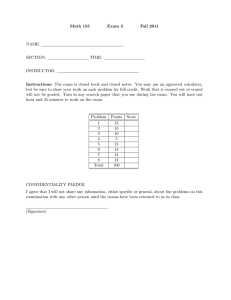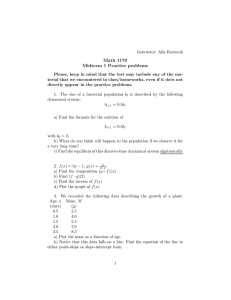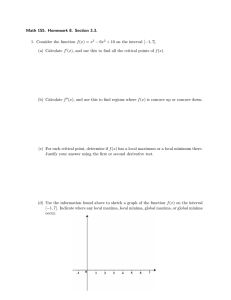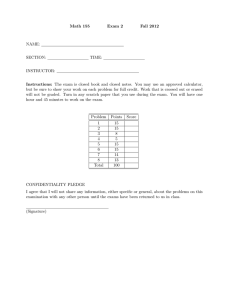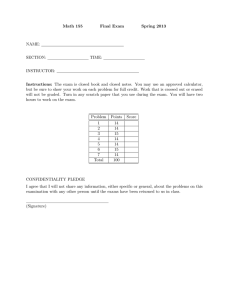Math 155 Final Exam Fall 2012 NAME:
advertisement
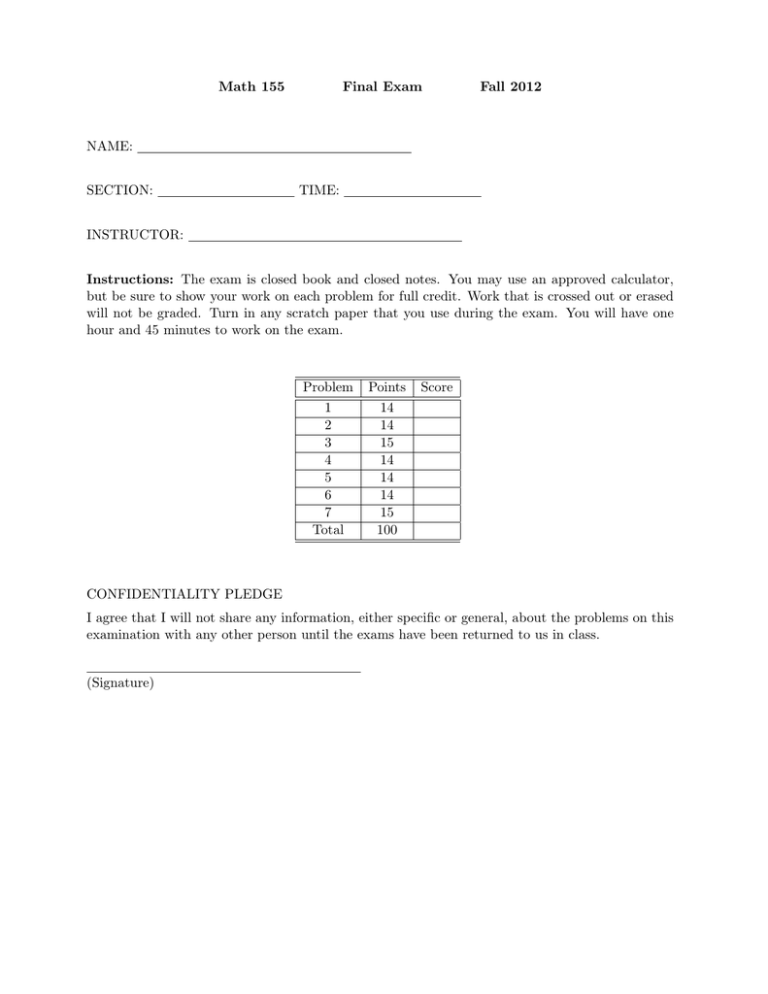
Math 155 Final Exam Fall 2012 NAME: SECTION: TIME: INSTRUCTOR: Instructions: The exam is closed book and closed notes. You may use an approved calculator, but be sure to show your work on each problem for full credit. Work that is crossed out or erased will not be graded. Turn in any scratch paper that you use during the exam. You will have one hour and 45 minutes to work on the exam. Problem 1 2 3 4 5 6 7 Total Points 14 14 15 14 14 14 15 100 Score CONFIDENTIALITY PLEDGE I agree that I will not share any information, either specific or general, about the problems on this examination with any other person until the exams have been returned to us in class. (Signature) 1. (14 points) Evaluate the following definite and indefinite integrals. substitution. Show all of your work. Z 5x4 + 2x2 + π dx x3 Z t3 sin(t4 + 7)dt (a) (b) Z (c) 1 3 dx 3 0 (2x + 1) Z (d) Use integration by parts to evaluate 2 5xe4x dx. If necessary, use 2. (14 points) Consider the discrete-time dynamical system Nt+1 = 2Nt (1 − Nt ) − hNt describing a population of shrimp being harvested at rate h ≥ 0. (a) Find the nonzero equilibrium population N ∗ as a function of h. For what values of h is there a positive equilibrium? (b) The equilibrium harvest is given by P (h) = hN ∗ , where N ∗ is the equilibrium you found in part (a). Find the value of h that maximizes P (h). Use the first or second derivative test to justify that this value of h gives a local maximum. (c) Use the Stability Test/Criterion to determine if the equilibrium you found in (a) is stable if h = 12 . 3 3. (15 points) Consider the function f (x) = −x3 + 3x2 + 9x on the interval [−3.5, 4]. (a) Calculate f 0 (x), and use this to find all the critical points of f (x). (b) Calculate f 00 (x), and use this to find regions where f (x) is concave up or concave down. (c) For each critical point, determine if f (x) has a local maximum or a local minimum there. Justify your answer using the first derivative test. (d) Use the information found above to sketch a graph of the function f (x) on the interval [−3.5, 4]. Indicate where any local maxima, local minima, global maxima, or global minima occur. 4 4. (14 points) Let P (t) be the amount (in moles) of a chemical being formed in a reaction. Suppose that the rate at which the chemical is being formed is given by dP 2t = 2 moles/sec. dt t +5 (a) What is lim t→∞ dP ? dt (b) If P (0) = 5, what is P (t)? (Solve the initial-value problem for P (t)). (c) Find the average rate at which product is being formed (that is, the average value of 2t dP dt = t2 +5 ) between times t = 0 and t = 2. (d) Use a definite integral to find the total change in the amount of product between times t = 1 and t = 5. 5 5. (14 points) Suppose that a cell is absorbing a certain drug from its environment. At time t = 0, there is 10 mol of the drug in the cell, and the drug enters the cell at a rate of 1+sin(t2 ) mol/min. (a) Let c(t) represent the amount (mol) of drug in the cell at time t (in minutes). Write a pure-time differential equation and an initial condition for the situation described above. (b) Apply Euler’s Method with ∆t = 0.5 to estimate the amount of drug in the cell at time t = 1.5. Show your work clearly using a table. 0 (Recall the formula cnext = ccurrent + dc dt ∆t, or ĉ(t + ∆t) = ĉ(t) + c (t)∆t.) 6 6. (14 points) (a) A flying big brown bat slows down a bit to catch a fly, and then increases its speed again as it flies on. Denoting the position (in meters) of the bat at time t (in seconds) by P (t), suppose that the bat’s velocity is given by dP t2 =1− . dt 1 + t4 Estimate the total change in P (t) between times t = 0 and t = 2 using a right-hand Riemann Sum with ∆t = 0.5. Draw your rectangles or step functions on the graph below. 2 1 (b) The density of a very thin rod varies according to ρ(x) = 10 xe2x in grams/cm, where x marks a location along the rod and x = 0 at one end of the rod. What is the total mass of the rod if it is 2 cm long? 7 7. (15 points) (a) A population of green, slimy algae obeys the discrete-time dynamical system at+1 = 1.8at . (i) Write down the solution of this discrete-time dynamical system if a0 = 500. (ii) If a0 = 500, at what time does the population reach size 1000? (b) Use a tangent-line approximation of the function f (x) = your answer to 3 decimal places. √ x to approximate √ 3.9. Give (c) Suppose that the population k(t) of green kingfishers (measured in thousands) satisfies the differential equation dk = 3.1k(2.2 − k). dt i) Find all equilibria of the differential equation. ii) Write down an initial condition for which the population will increase with time. k(0) = 8
